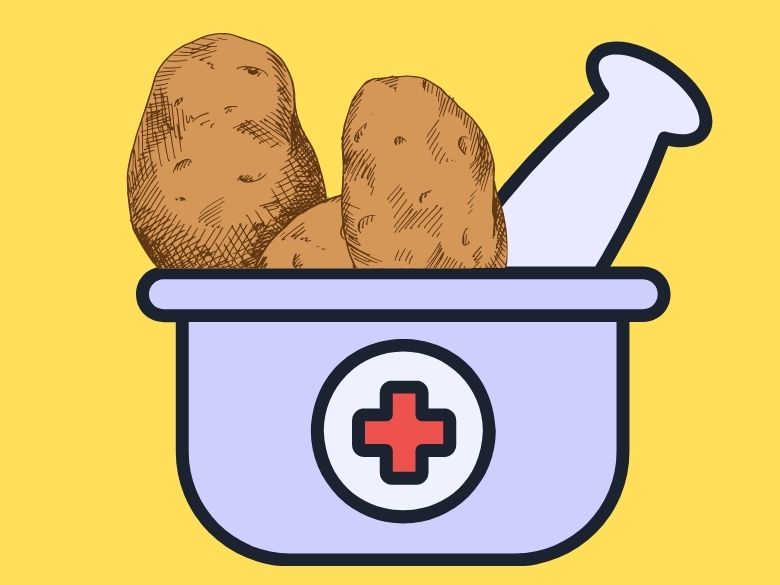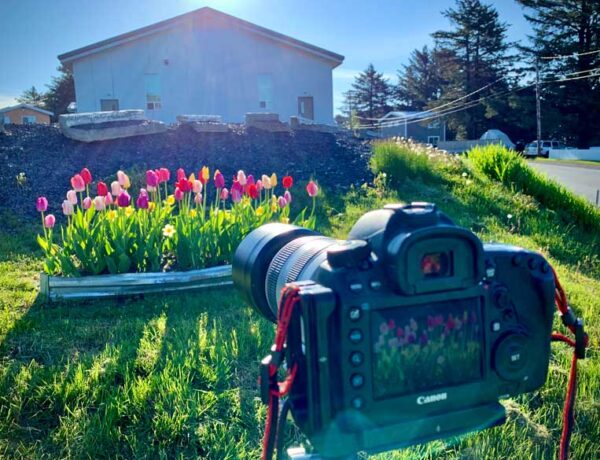When it comes to comfort food, the potato holds the top spot. But there’s more to the potato than meets the fry…
[perfectpullquote align=”full” bordertop=”false” cite=”” link=”” color=”” class=”” size=””]According to National Geographic, the average American eats nearly 30 pounds of French fries each year. [/perfectpullquote]
For Charlaine Siefert, the potato is more medicine than food.
In fact, potatoes have been in Charlaine’s home medicine kit for over 50 years.
“The introduction to its use was a gift from my grandmother, Grandma Boswell of Plummer, Idaho,” she shared with me years ago, over a cup of coffee.
If you Google “potato natural medicine” you’ll come up with a long list of remedies, from preventing wrinkles and acne to curing warts and healing sunburn.
But, as you’ll see in Charlaine’s story, the lowly potato, specifically the Idaho (Burbank) potato, has been kept in high regard in her family…
[Hi, it’s Marion. This article was originally published in the Kodiak Daily Mirror, the hometown newspaper for Kodiak, Alaska. Go here to access the archive page for the list of my past columns, written each week since 1986].
Born in rural Coeur d’Alene, Idaho in 1949, Charlaine now lives in Kodiak. As a child, she spent most of her waking hours outside, climbing trees, catching tadpoles, swimming, fishing, hiking–All the things kids love to do.
1. The bee sting
One day, when she was twelve, Charlaine was stung by a bee.
The wound swelled up hot and red. Her grandmother, who Charlaine refers to as a ‘pioneer healer,’ cut a potato and placed it flesh-side down, on the site of the sting.
Then her Aunt Nora wrapped a clean, white rag around the piece of potato. By morning, all the swelling and pain were gone.
[perfectpullquote align=”full” bordertop=”false” cite=”” link=”” color=”” class=”” size=””] It was the beginning of a beautiful relationship with the lowly spud. [/perfectpullquote]
2. The ankle
Sometime later, Charlaine sprained her ankle. “My grandmother did the same thing,” she said.
“She peeled a potato and applied several strips of potato to my ankle, and secured them with a white cloth which she safety-pinned in place.” By the next day, the swelling was gone.
3. The cyst
Many years later, Charlaine and her husband were stationed in Stuttgart, Germany.
“He developed a cyst on the back of his neck. When it became inflamed he went to a doctor, who proceeded to lance it using no anesthetic.”
Her husband returned from the clinic, without relief. He was in terrible pain and begged her to do something about it.
“The sore looked awful but I didn’t know what to do.
“Then I remembered the raw potato application that my grandmother had used on the bee sting. I told him that was the only thing I knew, but I would try it if he wanted. He was so uncomfortable, he agreed.”
Charlaine peeled the potato and placed it on the wound, then secured it with a large Band-Aid. “The potato pulled out the pus and infection, and the inflammation and pain went away.”
Charlaine changed the potato dressing every day, and though she doesn’t remember how long it took the wound to finally heal, the pain was gone by the next day.
4. The spider
Years passed. Charlaine was divorced and living by herself. One night, she was bitten by a Hobo spider and because she had lost some sensation of touch due to diabetes, she didn’t realize right away what had happened.
“I remember the itching, but I was busy I didn’t bother to examine my leg. When the itching turned to pain, I looked at my lower leg and discovered a large, open wound with an oozing sore and blackened skin. A friend looked at it and said it was necrotic and smelled.”
That got her attention. Charlaine tried antibiotics, but nothing happened.
“It looked so bad, I was actually afraid to go to the doctor,” she said, “though I did make an appointment for a week away.”
Then she tried the potato. She peeled a chunk and put it on the sore and secured it with a bandage.
After 24 hours, she peeled back the bandage. To her relief, the redness had gone down and the potato had absorbed some of the infection.
“I changed the potato peeling and left it on until I went to the doctor,” she said.
She kept her doctor’s appointment. As the physician examined the wound, Charlaine shared her experiences with her grandmother and how the healer of the family used the potato.
Then it was her doctor’s turn. “She went on to explain that the potato has properties that can assist in healing,” Charlaine said.
“She told me it could draw blood to the surface and the sugars in it could speed up the healing process.” As if to make a point, Charlaine’s wound had decreased in size and though still not healed, it was much improved.
“My doctor did prescribe an antibiotic, though.”
Charlaine decided to continue with the potato treatment and to hold off on taking the antibiotics unless the infection started to look worse.
[perfectpullquote align=”full” bordertop=”false” cite=”” link=”” color=”” class=”” size=””]“It took three weeks, but it cleared up with almost no scarring.”[/perfectpullquote]
Today, Charlaine still copes with diabetes and the consequences of poor circulation. “When I get blisters on my feet I turn to the potato to heal them. And just in case, I have a physician check them if they didn’t look better within a day or so.”
And that’s not the end of the story.
1. The foot
While working on her master’s degree, Charlaine also held different jobs. She kept a lot of balls in the air and was often exhausted at the end of the day.
One day, she heard a loud ‘crack’ when she stepped down on her foot. It puffed up immediately and the swelling began to spread up her leg. After four weeks, and continuing trauma to her foot, she went to a doctor.
The initial diagnosis included a possible stress fracture, even though no fracture showed up in the x-rays. “I wasn’t given anything for inflammation or infection,” she said. “And by this time, it was very painful to walk.”
She was given a ‘boot’, a sort of temporary cast, which helped somewhat, but the swelling continued, along with redness and pain. “They told me I’d be looking at six months in a cast. I remember thinking, ‘what is this going to mean to my life?’”
Once again, Charlaine thought about the potato. She applied it to her foot and secured it with an ace bandage. Within two days, there was a visible improvement. Within a week, most of her foot had returned to normal.
[perfectpullquote align=”full” bordertop=”false” cite=”” link=”” color=”” class=”” size=””]After two weeks, there was no redness and swelling.[/perfectpullquote]
“Though my foot is still tender, it was greatly improved. The doctor told me to continue with what I was doing.”
At the end of our interview, I asked Charlaine, “What’s next for you?”
[perfectpullquote align=”full” bordertop=”false” cite=”” link=”” color=”” class=”” size=””]“I’m not sure what the future holds, but I think I’ll create a refrigerator magnet in the shape of a Russet potato as a reminder of Grandma’s gift.”[/perfectpullquote]
The Kodiak garden calendar for May
Speaking of potatoes: Gardening lore says to plant root crops when the moon is waning, which is the two-week period that begins after the full moon on Monday, May 16, and runs until May 30.
Remember to plant only certified seed potatoes. It’s not a good idea to make use of store-bought potatoes. They might have been sprayed with an anti-sprouting treatment (common) and they might carry diseases we don’t want to appear in Alaska.
Thank you for being here.
Cheers!

Here are more resources for you:
Hi gardeners! Want to create your dream garden? You can do it, step-by-step with Marion Owen: The Gardener’s Coach. Visit my YouTube channel: The Gardener’s Coach.
Compost is the answer to everything in the garden!
And if you have enough of it, you won’t need much of anything else. To learn more, take my 60-second assessment.





No Comments